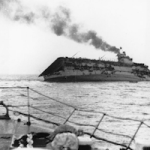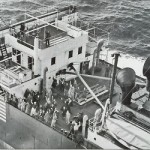At the beginning of World War I in July, 1914, Germany had 48 submarines, or “U-boats” (for Unterseeboot), in service or under construction. The German boats would prove more reliable and more lethal during the course of the conflict. Indeed, a German U-boat, U-21, was the first to sink a warship with a self-propelled torpedo when she attacked H.M.S. Pathfinder, Sept. 5, 1914.
In the opening months of the war, submarines, like their surface ship counterparts, observed the traditional “prize rules” with regard to merchant shipping. That is, merchant ships were stopped and captured or they were sunk once their crews were taken off the ships. But on Oct. 20, 1914, U-17 torpedoed and sank the first merchant ship of the war, the British-flagged S.S. Glitra, without observing the prize rules.
By February of 1915, Germany’s Kaiser Wilhelm II declared the waters around the British Isles to be a “war Zone” in which any ship could be attacked without warning, setting the stage for one of the war’s most dramatic events. On May 7, 1915, U-20 sank R.M.S. Lusitania off the Irish coast, killing nearly 1,200 passengers and crew, including 128 Americans.
The shocking deaths of so many civilians stunned the world. The United States, at the time a neutral country in the war, threatened to sever all ties with Germany. The threat prompted Germany to reinstate the prize rules in full and order seemed to have been restored. U-boat tactics involved surfacing to surprise a merchant vessel, advising its crew to abandon ship, then using the U-boat’s deck gun to sink the ship. Torpedoes were expensive and less reliable than surface fire so they were used sparingly.
A year later, at the end of May, 1916, the German and British fleets clashed in the Battle of Jutland. Although Germany claimed victory, the Royal Navy remained firmly in control of the seas. As a result, German naval high command argued to abandon the prize rules and resume attacking merchant shipping. They gambled that a high rate of merchant shipping losses would force Britain to sue for peace before the U.S. could effectively enter the war.
By the end of January, 1917, Germany announced its U-boats would henceforth conduct unrestricted warfare against all shipping. In mid-March, Germany sank three American merchant ships. The U.S. declared war on Germany April 4. The German tactics were initially effective, but the introduction of the convoy system later in the year reduced the U-boats’ success rate and in the end, Germany failed to sink enough Allied shipping to gain victory or even a stalemate.
In the final counting, Germany built 373 U-boats during the war and lost 178 to Allied action. But U-boats sank more than 30 warships and 5,000 merchant and fishing vessels, killing 15,000 sailors and civilians. In the minds of many merchant seamen the submarine had become a weapon of terror, and many negotiators at Versailles pushed to outlaw the submarine altogether.
In our next blog we will look at how the submarine navigated the interwar period.





